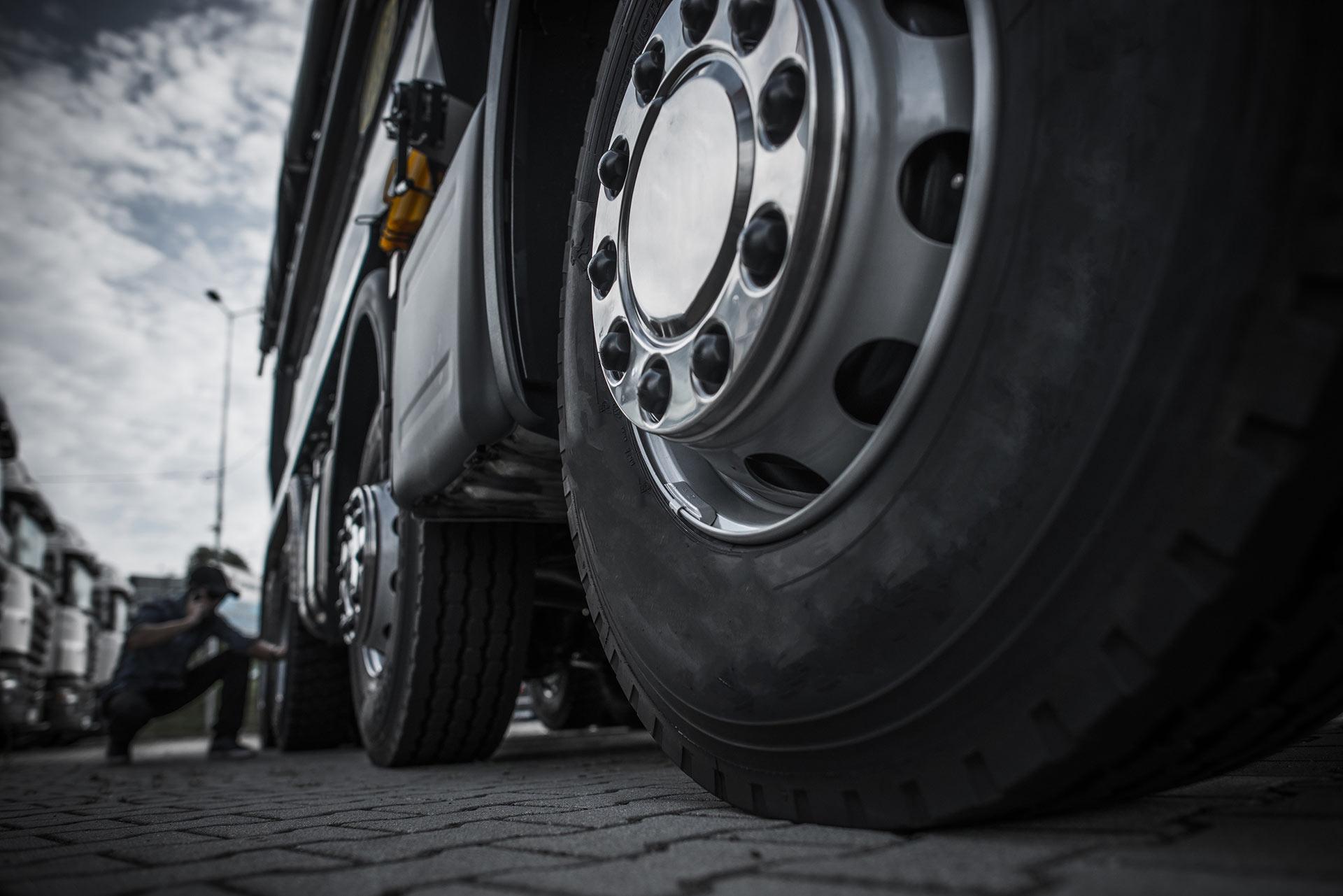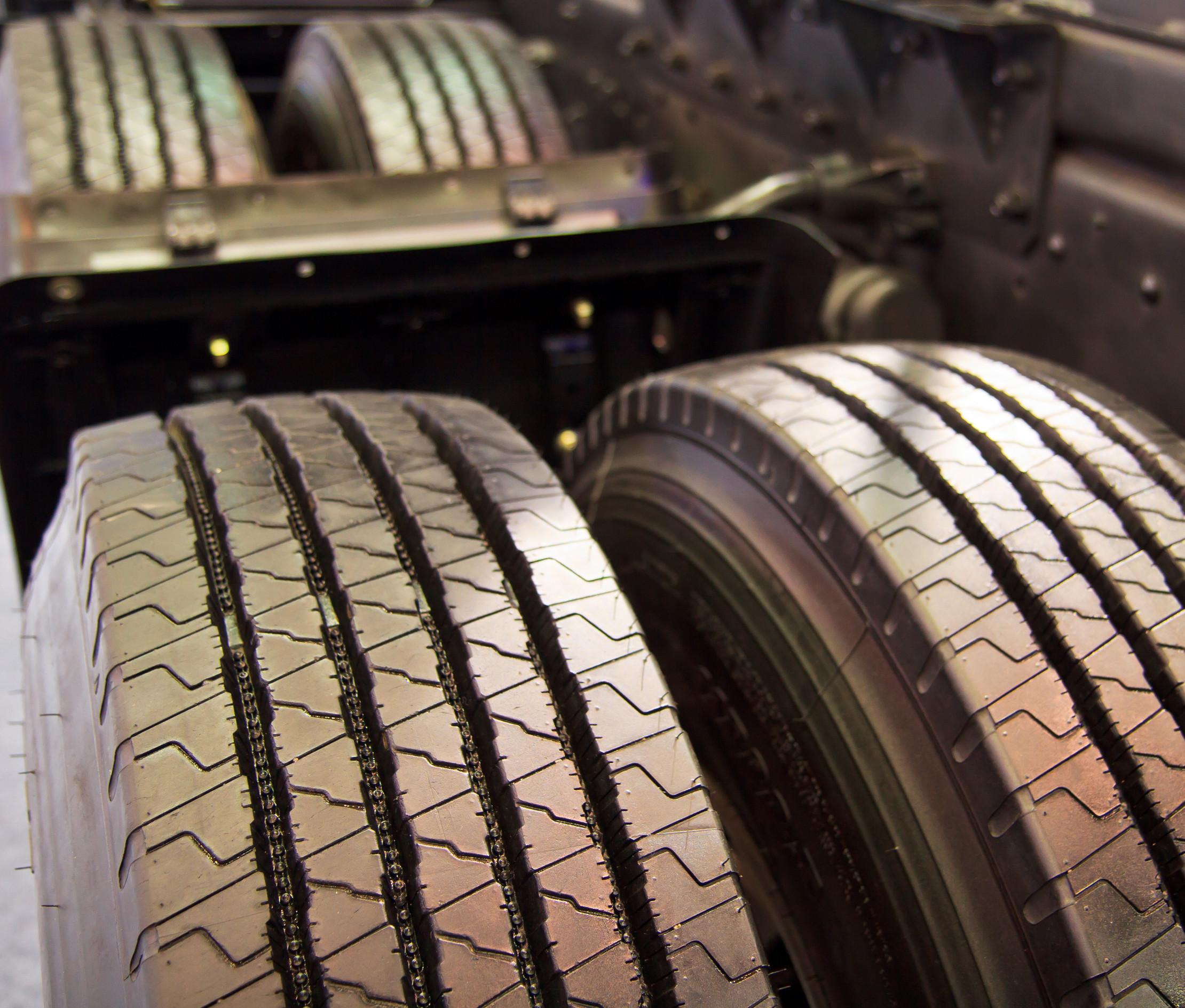Choosing the Right Semi-Truck Tires to Optimize Performance
April 10th, 2025
By Arrow Truck Sales

Tires are one of the most essential parts of your truck. They keep you rolling and affect fuel efficiency, traction, safety, ride comfort, and long-term operating costs. Tires affect everything, so picking the right tires for your specific driving conditions is critical.
Getting the right tires is not just about finding the most durable or cheapest option; it's about ensuring your tires are matched to your routes, loads, climate, and equipment. That's how you get more life out of every mile and avoid problems with mismatched or worn-out tires.
Let's break down what to look for when choosing tires.
Four Main Types of Semi-Truck Tires
Every commercial truck runs on a combination of tire types, and each one plays a different role.
Steer Tires
– These are on the front axle and are responsible for handling, turning, and absorbing road shock. They must offer precise control, even wear, and strong wet-weather grip.
Drive Tires
– Located on the powered axles, drive tires are all about traction. They have deeper treads and are engineered to push the truck forward, especially in harsh conditions.
Trailer Tires
– Trailer tires are found on the trailer axles. They are there to carry the load without being involved in propulsion. These tires are built for durability and resistance to sidewall damage from sharp turns or curbs.
All-Position Tires
– These are designed to be flexible enough to go on any axle, but they're mainly used on steer positions for regional or urban routes with lots of turns and stops.
Knowing how each tire functions helps you make better decisions based on where you drive and what you haul.
Matching Tires to Your Route
Not all roads are the same—and your tires shouldn't be either. Tire compounds, tread depth, and casing construction are all designed with specific environments in mind.
Long-Haul Routes
If you’re running coast-to-coast or logging long stretches on the interstate, you need tires that can go the distance without burning through fuel. For this kind of driving, low rolling resistance is the name of the game. Look for:
Treads that stay cool and handle heat without wearing unevenly.
Rubber compounds that are built for long life and don’t break down under constant highway speeds.
A design that gives you a smooth, steady ride and consistent contact with the road, mile after mile.
Regional Hauls
For drivers working shorter routes with a mix of city and highway miles, it’s all about versatility. You need tires that can handle the stop-and-go and still hold up on the open road. In these cases, hybrid tread patterns are a smart move. These tires:
Take
frequent starts, stops, and turns
in stride.
Are built tough for
mixed surfaces
and more varied road conditions.
Give you
more rotation flexibility
, which helps extend tire life across all positions.
Urban and Last-Mile Delivery
City driving comes with its own set of challenges—tight corners, potholes, and plenty of curbs. Tires need to be tough and agile to keep up with the pace. For these routes:
Go for tires with reinforced sidewalls—they hold up better against curb damage.
Choose tread patterns that are designed to prevent irregular wear, especially with lots of turning and braking.
All-position or urban-rated trailer tires are a solid pick here—they’re made for the daily grind.

Load Type and Weight Matter
Your tires don't just respond to the road—they also respond to what you're hauling. A heavy load puts more pressure on every axle, which increases the stress on tires.
For heavy or oversized hauls:
Choose tires with higher load ratings and reinforced casings.
Ensure your inflation pressure is adjusted based on the actual weight of your load.
Consider double-checking tire temperature during long runs, especially in the summer months.
Even when you're hauling lighter loads, your tires still need to be optimized, though you might have more flexibility in tread design or rubber compound.
Seasonal and Terrain Considerations
One-size-fits-all doesn't apply in trucking tires—especially when the weather or terrain shifts.
Winter Tires
– If you're regularly running through mountain passes or northern states in winter, winter-specific drive tires give you better traction in snow and ice, which is worthwhile even though it lowers fuel economy.
All-Weather Tires
– These offer a balance between performance and year-round usability for moderate winter conditions.
Off-Road Rated Tires
– Construction, logging, or oil field work requires tires that can handle gravel, mud, and unpaved roads without breaking down under stress.
Wet-Weather Grip
– If your routes often involve rain or standing water, look for tread patterns designed to resist hydroplaning.
The right tire can be the difference between traction and trouble—especially when conditions get tough.
The Risks of Mismatched or Poorly Chosen Tires
Choosing the wrong tires—or mixing incompatible types—doesn't just wear them out faster, it can cause real problems, including:
Irregular tread wear
and shortened tire life
Decreased fuel economy
from extra rolling resistance
Poor handling
, especially in wet or slippery conditions
Vibration, noise, or uneven ride
that adds stress to your suspension
Higher risk of blowouts or sidewall damage
on long hauls
Tires should always be selected as a system—not just one at a time. Matching steer, drive, and trailer tires based on use case ensures safer, smoother, and more cost-effective operation.
Routine Inspections and Preventive Maintenance
Even the best tires won't perform well if they're not properly maintained. Regular semi-truck preventative maintenance can help you catch minor problems before they become expensive ones.
Keep an eye on your tires. Look for:
Tread depth
– Check for uneven wear and replace tires before they hit the minimum.
Air pressure
– Under- or over-inflated tires wear out faster and reduce fuel efficiency.
Alignment and suspension issues
– If your truck pulls to one side or feels unstable, it could be a tire or axle issue.
Damage
– Cuts, sidewall bulges, or exposed belts are signs a tire needs to be replaced immediately.
Building tire checks into your daily pre-trip inspection is one of the easiest ways to keep your truck safe and efficient.
Find the Right Truck with the Right Tires at Arrow Truck Sales
Choosing the right tires is easier when the truck is already spec'd for the job. At Arrow Truck Sales, we help drivers and fleet managers find quality used trucks equipped with the right tire setups for long-haul, regional, or urban work.
Our team understands that performance isn't just about the engine—it's about how the truck rides, how it handles, and how long it lasts. With 75 years in the business, Arrow gives you the confidence to buy, knowing you're getting a truck that's built for the road ahead—right down to the tires.
Whether you're just starting out or upgrading your fleet, the right tire strategy helps control tire costs, lower fuel costs, improve safety, and extend the life of your equipment.
Tires Do More Than Keep You Moving
Tires aren't just another line item on your maintenance list—they're one of the biggest factors in your truck's overall performance, safety, and efficiency. Choosing the right ones, maintaining them properly, and understanding how they support your load and route will keep you rolling longer, safer, and with more money in your pocket.
When it's time to find the right truck to match your operation, Arrow Truck Sales is ready to help.

